Archives
Reuters technical development chronology 1970-1974
Monday 6 July 2015
- As traffic rates increase, a third TDM is introduced known as TATPAC (Transatlantic and Pacific), which feeds the Far East. Started in September 1970 with London to Montreal, followed by Hong to Tokyo in October 1970. Special development by Reuters engineering is required both on Videomaster as well as TATPAC in order to allow clients in Tokyo to interrogate the system in London. It becomes without doubt the longest real time interrogation circuit in operation in the world.
- DEC introduces the 16 bit PDP-11 as a successor to the PDP-8.
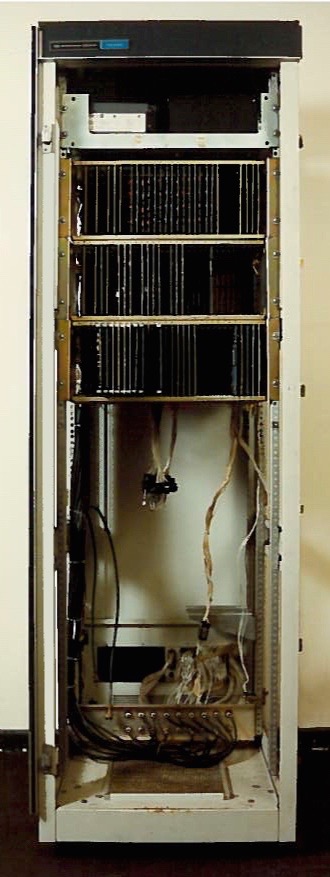 The first Videomaster installations in Europe are made in Paris and Geneva offering 10,000 quotations from 33 markets. A very large six-foot cabinet of electronics comes free with every terminal.
The first Videomaster installations in Europe are made in Paris and Geneva offering 10,000 quotations from 33 markets. A very large six-foot cabinet of electronics comes free with every terminal.
PHOTO: Videomaster cabinet
- Ultronic/GTE build a new datacenter at Mount Laurel, New Jersey.
- Glen Renfrew relocates to manage the US business and sets up a development group, initially in New York, and later in Farmingdale, Long Island. It is named IDR Inc (Information Dissemination and Retrieval, or variously I Don’t Remember or I DRink) and has the goal of exploiting the use of television broadcast technology for distribution of information on coaxial cable systems. This approach was pioneered in the UK and used by the BBC in Ceefax and ITV in Oracle for simple character transmission. The same technique is used by the European Broadcasting Union to encode ambient sound in their international television transmissions avoiding extra sound circuits. In each case the information is carried in the vertical interval lines of the television frame. IDR extends the idea and uses all the lines of a US TV frame. Data is transmitted in the signal, constantly recycled at intervals and terminals “grab” requested data as it flows by. Initially known as Framegrabber, it later becomes known as Rowgrabber. It is also a broadcast and display system and like SGS does not recover lost data.
- TATPAC becomes fully operational with the connection of Montreal to New York, Montreal to Sydney and Sydney to Hong Kong. It is one of the most advanced multiplexing systems of its kind in operation.
- A second US-based development group is set up in New York to focus on processing market data and the requirements of editorial. The Newsview service starts up in Reuters North America (RNA). It is based on PDP-8s and feeds cable companies over 9.6bps lines. It offers three channels of alphanumeric news displays - general news, financial news and sport. The cable companies cycle the text onwards to subscribers. It is too limited to be of real professional use but it generates the iconic scrolling ticker round the Time building in Times Square, Manhattan and is arguably the first in the field to distribute information for display using computer technology rather than teleprinter technology.
- On which topic, more than 1,000 Extel printers operating at 75 baud are purchased.
- Michael Nelson sets up a new computer services division in London. A hardware-only prototype system for a proposed Foreign Exchange (Monitor) product is demonstrated using old Ultronic equipment. However it is decided to use a software-based approach and the project is contracted out to Scicon, a central London-based software house with expertise in building turnkey real time systems.
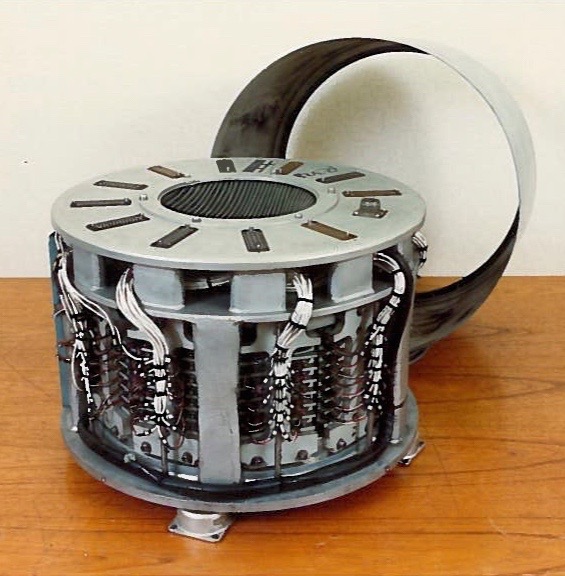 Commissioning trials for the second generation of slave storage units (SGS) begin in Mount Laurel, New Jersey.
Commissioning trials for the second generation of slave storage units (SGS) begin in Mount Laurel, New Jersey.
PHOTO: SGS drum
- The Monitor system is delivered in June. The product (well documented elsewhere) is based on the idea of a contributor owning one or more pages each identified by a four character code. Each page consists of 12 rows of 64 uppercase characters laid out in a tabular fashion. The contributor/owner decides who can/cannot view the page. Changes to a page are distributed in real time to those with it on display. The flexibility, speed and real time nature are groundbreaking technical attributes. The system has a conventional architecture with a distributed database on PDP-11 hosts, each with 48kb core memory and a 256kb disk. PDP-8s are used as intelligent terminal controllers, instead of dumb screens, each with 1,000 words of memory for the software which turns out to be a bit of a squeeze. The host systems can be switched in real time in case of failure, i.e. a hot standby, and the terminals are downloadable. Both are advanced features for the day. Data loss is overcome by using an acknowledgement protocol between the host and the terminal controller. A limitation of the video controller is the 64x16 character display which later proves to be a competitive disadvantage. However from Stockmaster with three digits in lights and Videomaster with 72 digits in a display, Monitor with over 1,000 characters in a display was a huge step forward. Initially there are supposed to be 15 contributor/recipients and 15 recipients with a design limit of 250 total client connections. In fact Money Rates is launched with five contributors.
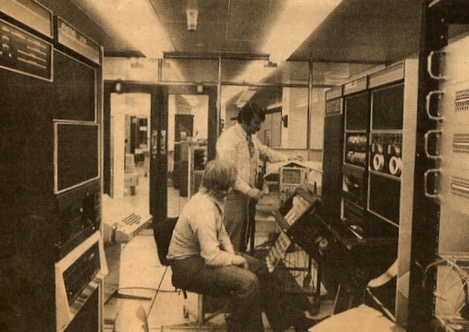
PHOTO: William Liversedge (nearest camera) and Herbert Gross testing a brand new Monitor Host, May 1973
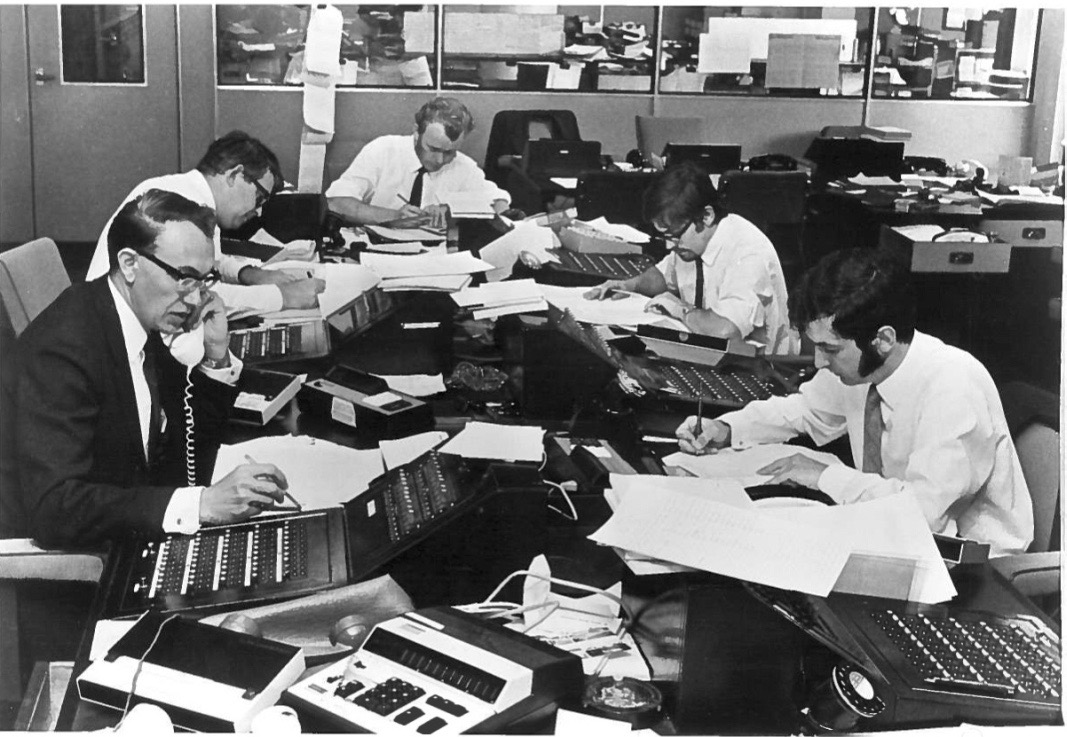 Reuters engineers produce a multi-line interface for the cost effective connection of the numerous telephone lines to the Monitor Host. DEC produce a similar device 18 months later but this Reuter innovation enables Monitor to operate efficiently and economically in the intervening period and without the otherwise severe constraints on connectivity which would have hampered expansion.
Reuters engineers produce a multi-line interface for the cost effective connection of the numerous telephone lines to the Monitor Host. DEC produce a similar device 18 months later but this Reuter innovation enables Monitor to operate efficiently and economically in the intervening period and without the otherwise severe constraints on connectivity which would have hampered expansion.
PHOTO: Typical foreign exchange dealing room before Monitor
- A video editing system to replace the typewriter-editor-copy boy-telegrapher chain is completed and installed in New York. News database systems are developed in London based on PDP-11s and editing terminals in New York based on PDP-8s. Smaller versions are installed in Europe. The outputs are still 50 and 75 bps wire services so there is not much changes for clients.
- New York development completes Prequote and Quote systems which process tickers from NYSE (New York Stock Exchange) and CBOT (Chicago Board of Trade) exchanges and feed the early Newsview and other cable and printer services. One important benefit is the automation of price extraction for wire service proformas saving cost and delay. Prior to this the prices were manually extracted from SGS and retyped.
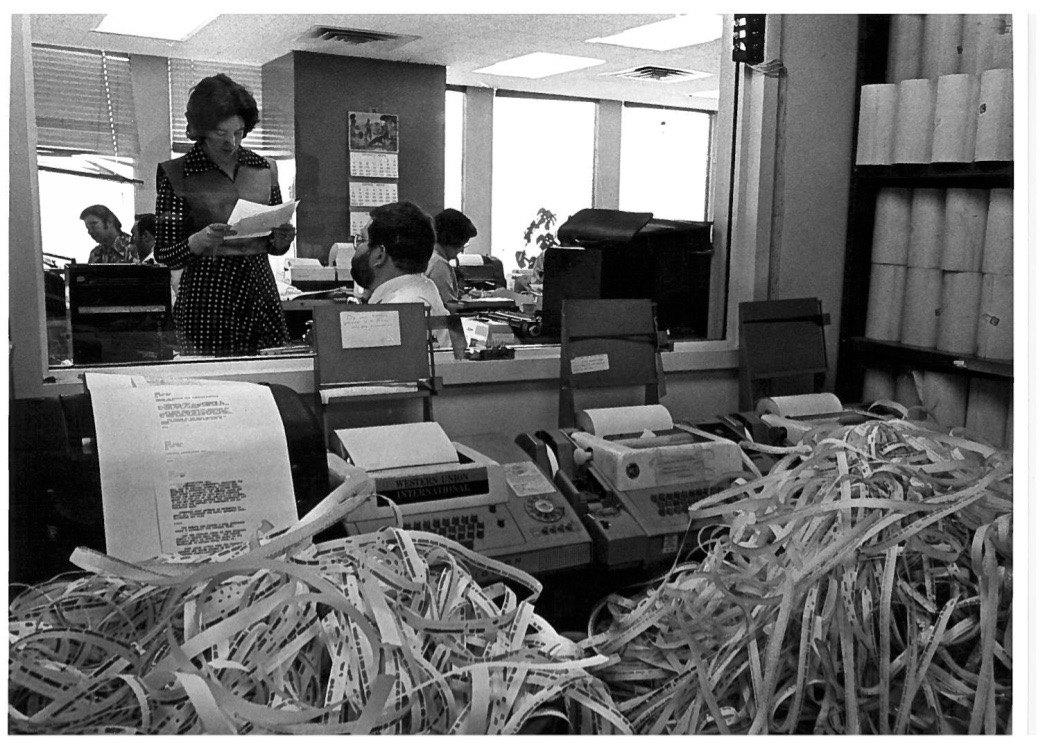
- Monitor goes live in New York with two communications links to London - 150bps and 300bps.
- An IBM1130 is installed in London and an interface is cobbled together to feed prices to the Financial Times. It is probably the first data feed.
PHOTO: Financial editor Maggie Klein in New York newsroom in the era of teleprinters
- Reuters become a founding member of INTUG (International Telecommunications User Group). This active user group, much prompted by Reuters, is set up to challenge the exorbitant charges levied by the telecommunications authorities as well as the “no third party traffic rule” (if you leased a circuit you could theoretically only use it for your own business activities). It also confronts issues such as customers paying a premium to combine information from different sources transmitted over international leased lines.
- An early automated contribution facility to Monitor goes live for Mocatta Metals. It uses special software and initially overloads Monitor due to the enthusiasm of the contributor. This is the first lesson on the need for throttling controls on inputs. Monitor has now progressed in one year to 111 customers connected with 59 pending.
- A working prototype Rowgrabber system is demonstrated by IDR. Information is gathered and processed by a central computer (the cable head) and then transmitted to the cable systems head-end. At a major New York launch event, Reuters announce the new service aimed at the investment community and the television viewer at home. Advantages quoted include constant response times and no delays for a four million words per minute service. “It can answer almost any question most people would be likely to ask of a news service.” Content derives from NewsView, Quotes from market ticker processing systems and money rates from Monitor. It uses a channel in the Sterling Manhattan cable and a further $300,000 for development is earmarked. A 10-year agreement is made with Sterling Manhattan.
- Further development is required on the terminals, especially for a cheap home device which allows a subscriber to cable TV to retrieve information on a home TV set. IDR pioneers the use of microprocessor technology in these early frame grabbing terminals; the four-bit processor from Rockwell and later the eight-bit Z-80 from Zilog. The IDR knowledge base increases with research into processor chips from Motorola and a fledgling company called Intel.
- In London, investigations start on the feasibility of solving Reuters’ communications needs with a general purpose packet switching network. A project known as SWM (SoftWare Multiplexing) is set up. Invitations to tender are issued but nothing much happens until 1977.
- « Previous
- Next »
- 5 of 18